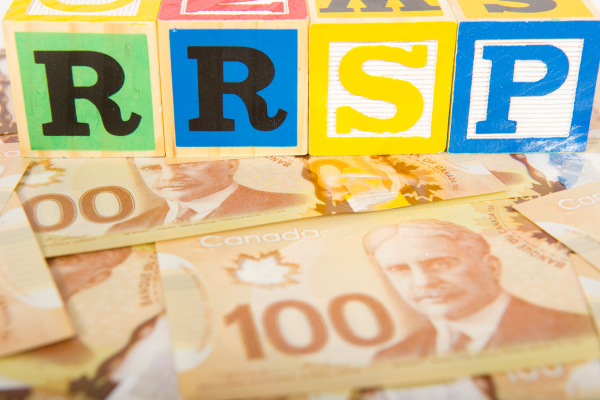
Retirement savings are essential for all Canadians to live comfortably after they retire. And the earlier you start saving, the better. For newcomers, understanding retirement savings options can be confusing. So in this article, I’ll demystify the Registered Retirements Savings Plan (RRSP). With a clear understanding, you can start saving as soon as possible to achieve your dreams and goals in Canada!
What is a Registered Retirement Savings Plan?
An RRSP is a tax-deferred retirement savings plan. This plan encourages you to save in your earning years so that you can have income in your retirement years.
The term “tax-deferred” means that when you open an RRSP and contribute to it, you can claim a deduction from your income. And any income earned in the RRSP remains tax-free unless you make a withdrawal from your RRSP. In other words, you defer or delay taxes until the time you make any withdrawal. Therefore, you can defer income taxes until later when you may be subject to lower taxes as your income goes down.
During the years when you earn a high income, you are subject to higher tax rates. So, contributing to an RRSP will help you lower your tax liability.
Am I Eligible to Open an RRSP?
You are eligible to open an RRSP if you satisfy these conditions and you:
- Have “earned income” from the previous tax year
- Reported the earned income to the Canada Revenue Agency (CRA) on your tax return
- Have not yet turned 71 years of age.
Can I Open More than One RRSP?
You can open multiple RRSP accounts. However, it will be easier to manage one RRSP account rather than tracking several accounts.
How Do I Set Up My RRSP? Do I Need to go to My Bank?
You can set up an RRSP through a:
- Bank
- Credit union, or
- Trust or insurance company.
[cjtoolbox name=’Buying A Home As A Newcomer Webinar’]
Related Posts:
First Time Home Buyer: Newcomer Tips
Building Credit History in Canada as a Newcomer
Do Newcomers Need to File an Income Tax Return
How Much Can I Contribute to My RRSP in the Current Year?
Computing the maximum RRSP contribution for the current year involves four steps.
STEP ONE:
Calculate 18% of the income you earned in the previous tax year. Add the following income to determine your earned income:
- Your employment income. Calculate this as taxable benefits minus union or professional dues.
- Net amount of rental income from renting real property. No other property income will be considered in computing earned income.
- Net amount of self-employment income.
- Research grants received or royalties received from your own invention or published work.
- Spousal support payments (alimony/maintenance) received due to a court order.
- Canada Pension Plan or provincial disability pension plan income received.
- Supplementary employment insurance benefits that the employer pays to you. A good example is the top-up payments (i.e. the difference between your salary and the amount that is paid by employment insurance) that your employer may pay during maternity or parental leave. Do not count any employment insurance benefits that you received from Employment and Social Development Canada (ESDC).
Less: Spousal support payments made.
No other income or capital gains will be considered as earned income for an RRSP.
Now multiply your earned income by 18%.
STEP TWO:
Visit www.canada.ca to find out the contribution limit for the current year.
In 2024, the website shows that the annual RRSP contribution limit is $30,780 (for tax year 2023).
STEP THREE:
Compare 18% of your earned income for the previous tax year as computed in step one and the annual contribution limit determined in step two.
Take the lesser of these two amounts.
STEP FOUR:
To the lesser amount that you determined in step three, add unused RRSP contribution room from the previous years that were carried forward to the current year.
Now, subtract the:
- Previous year’s pension adjustment (PA)
- Current year’s past service pension adjustment (PSPA).
Now, you have arrived at your maximum RRSP contribution for the current year. The maximum RRSP contribution is also known as:
- Contribution room
- RRSP deduction limit, or
- Deduction room.
What Does Pension Adjustment (PA) Mean?
If you participate in a registered pension plan or a deferred profit-sharing plan, you earn pension benefits. This is the amount of PA.
What is Past Service Pension Adjustment (PSPA)?
In simple terms, PSPA is the amount of extra pension credits you get when either there is:
- An upgrade in your pension benefits or
- A pension buyback.
In a pension buyback, you pay a fixed amount to purchase years of missed pensionable service to enhance your retirement pension. For example, you can miss pensionable service years when in your earning years you:
- Took a leave of absence or time off your work or
- Deferred the decision to join your employer’s pension plan.
Thereby losing the opportunity to accumulate years of service in the pension plan.
The amounts of PA and PSPA go on to reduce your maximum RRSP contribution amount for the current year.
How Do I Calculate the Maximum Registered Retirement Savings Plan Contribution?
Let’s say you want to determine your maximum RRSP contribution for 2023 and you earned:
- $90,000 in employment income and
- $1,000 in taxable capital gains in the previous tax year (i.e. 2022).
- At the beginning of 2023, you have unused RRSP contribution room from previous years that total $7,000.
- As a member of a registered pension plan, your pension adjustment for 2023 amounts to $3,000.
To compute the maximum RRSP contribution follow these four steps:
STEP ONE:
Compute 18% of your earned income. In your instance, earned income will be $90,000. Taxable capital gains are disregarded while computing earned income. Thus, 18% of your earned income = 0.18 x 90,000 = $16,200.
STEP TWO:
On www.canada.ca, you find the RRSP dollar limit for 2023 is $30,780.
STEP THREE:
Take the lesser of the above two amounts. The lesser amount = $16,200.
STEP FOUR:
To $16,200, add the unused RRSP contribution of $7,000 and subtract your pension adjustment amount of $3,000.
So, your maximum RRSP contribution = $16,200 + $7,000 – $3,000 = $20,200.
Can I Make Excess Contributions?
Let’s take the above example. Since we worked out that your maximum RRSP contribution is $20,200, this is the maximum that you can contribute in the current year (in this case, 2023).
You contribute an excess amount of up to 2,000 without any penalty. But, any amount beyond $2,000 will be subject to a penalty of 1% of the excess beyond $2,000 for each month (or part of the month) that this excess contribution exists. For example, if your maximum RRSP contribution is $20,200, you may contribute:
$20,200 + $2,000 (excess amount not subject to penalty)
However, if you contribute, say, $23,200, there will be a penalty as computed below.
Split the amount of $23,200 as shown:
1. $20,200. This will not attract any penalty.
2. An excess amount of $2,000 which escapes any penalty.
3. An excess amount of $1,000 (which is beyond the excess amount mentioned in 2 above). This excess of $1,000 will attract a penalty of 1% for every month (or part of the month) that it remains in the RRSP.
Thus, you will pay $10 (i.e. 1% of $1,000) as a penalty for each month or part of the month that this amount remains in the RRSP.
If you make an excess contribution, make sure to withdraw it immediately to reduce the penalty as much as you can. Besides, you are not allowed to deduct from income any excess contribution. It, therefore, helps to avoid making excess contributions in the first place.
Is There a Deadline to Make Registered Retirement Savings Plan Contributions?
Yes, the deadline to make an annual RRSP contribution is typically at the end of February or early March for the preceding tax year. For the 2023 tax year, the deadline to make an RRSP contribution is Thursday, February 29, 2024. Most banks send deadline reminders so that you take advantage of this tax-saving benefit.
Are RRSP Deposits Insured?
If your financial institution goes out of business, the Canada Deposit Insurance Corporation (CDIC) insures up to $100,000 in deposits in seven categories.
The CDIC covers insurance up to $100,000 for the RRSP deposit category. Additional information on this is available at www.cdic.ca.
What about Withdrawals from the RRSP?
You can withdraw RRSP funds at any time. But any funds that you withdraw will be added as taxable income for the year that you withdraw funds. In other words, you will not get a tax break when you withdraw funds.
Can I Withdraw RRSP Funds to Buy a House or Pay for Education?
Two plans allow you to withdraw RRSP funds without being subject to taxes or interest:
1. Home Buyers’ Plan (HBP)
2. Lifelong Learning Plan (LLP)
However, both of these plans require you to pay back the amount that you withdraw. You must pay back the funds that you withdraw each year so that the amount that you withdraw for the HBP is paid within 15 years for the HBP and 10 years for the LLP.
When you withdraw RRSP funds for either program you will lose the tax-deferred income that you could have made on the amount that would have remained within your RRSP. Moreover, if you’re unable to pay back the annual dues, they get added to that year’s income and you’ll need to pay taxes on that amount.
What Happens When My RRSP Matures?

While you can withdraw from or register the RRSP at any time, you must deregister it by the end of the calendar year in which you turn 71. At that point, you have three options:
1. Transfer your RRSP proceeds to a registered retirement income fund (RRIF). Click here to learn more about RRIFs.
2. Withdraw the RRSP proceeds and pay taxes on the same in the year that you receive the proceeds.
3. Use the RRSP proceeds to purchase eligible annuities.
Can I Name a Beneficiary?
A beneficiary is a person your RRSP funds will go to if you die before your RRSP matures. You can name anyone of your choice as a beneficiary of your RRSP. However, from the tax deferral standpoint, it is better to name the following:
- Your spouse or common-law partner
- A child or a grandchild who is under 18 and is financially dependent on you at the time of your death
- A child or a grandchild who is mentally or physically informal and is financially dependent on you at the time of death. Age is irrelevant in this case.
What is a Spousal RRSP? How Does it Work?
Let’s say you make more money than your spouse (or common-law partner) does. And you know that the maximum RRSP contribution limit is restricted by your earned income.
If your spouse makes less money than you do, then the amount they can contribute to their personal RRSP will be lower. However, you’re able to make greater contributions to your own RRSP.
Now if you expect that your spouse’s earnings will continue to be lower than your earnings in the future, it makes sense to contribute more to a spousal RRSP. As well, if you withdraw funds from a spousal RRSP you will pay a lower tax rate on those funds.
Your contribution to the spousal RRSP will be limited by your personal limit. But because you make the contribution, you get to claim this as a deduction.
Related Posts:
Savings in Canada: Helping Newcomers Invest
Banking and Finance in Canada: Your First Steps
In summary, an RRSP can be a great way to save for your retirement in Canada. When you understand the financial benefits of an RRSP you can begin to save sooner and benefit from an early start.

